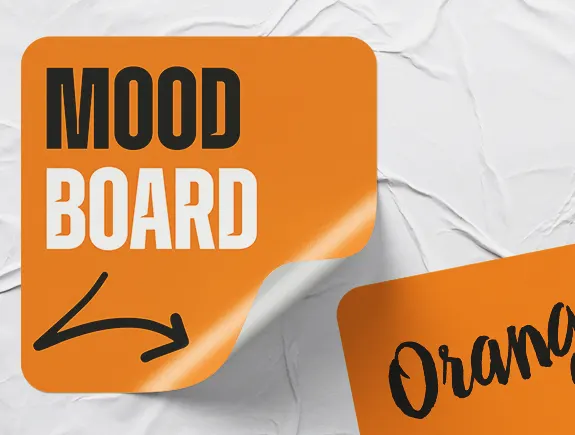Visual communication plays a crucial role in branding. Brands aim to convey their identity and values through logos, color palettes, fonts, images, and other visual elements. Mood boards are key to connecting these visible components to tell a cohesive brand story.
Brands use mood boards in the branding and marketing process for several key reasons:
- Clear Vision Communication – Mood boards provide a shared understanding to teams and stakeholders about what the brand aims to achieve. Instead of relying solely on verbal descriptions, mood boards enable crystal-clear visual communication.
- Inspiration – Mood boards stimulate creative ideas for visual components such as logos, branding, websites, products, photography, and more. The combination of images and textures sparks creative energy.
- Decision Making – When faced with creative choices, mood boards help decision-makers determine if the design aligns with the planned look and feel of the brand.
So, how did mood boards become so crucial in the brand-building process? Let’s briefly explore that below.
How Mood Boards Became the Rulers of Branding?
Interior designers and fashion stylists were the first to use mood boards in the 1960s and 70s to communicate ideas for spaces and clothing combinations. Images were taken from magazines and displayed on presentation boards – a purely analog approach.
Then came the digital transformation. The internet, graphic design software and new collaboration tools allowed remote teams to digitally create mood boards. Platforms like Pinterest, Milanote, and Mural brought mood boards into the digital age. Today, they are easy to create and bring many benefits to both clients and creatives working on their creations.
Why Are Mood Boards Relevant in the Modern Brand Building Process?
In an era where visual identity plays a crucial role, mood boards allow brands to convey their stories and values through carefully chosen visual elements. These “visual collages” provide a deeper understanding of the brand’s identity while serving as inspiration for creative ideas used in logo design, branding, web design, and other aspects.
Digital transformation significantly contributed to the flourishing of mood boards, enabling teams to create them remotely using various online tools. This flexibility facilitates collaboration and adds dynamism to the creation of visual identities. Moreover, in a world where consumers increasingly value emotional connections with brands, mood boards become a key tool for conveying the feelings and value a brand wants to communicate.
And this – mood boards have become a vital instrument in modern branding, providing a means of expression, inspiration for creativity, and a tool for maintaining consistency in the brand’s visual expression. Their adaptability and ability to meet the needs of modern brands make them an indispensable resource in creating authentic and strong visual identities.
Step by Step: How to Create a Killer Mood Board?
Creating mood boards is a blend of art and science. Follow these steps to create a “collage” that truly reflects the brand and its essence:
- Team and Process Organization – Before the creative process begins, a bit of structure helps. Outline themes, team member responsibilities, necessary resources, and project plans.
- Research – Gather images, color palettes, fonts, and textures relevant to the brand and its competitors. The analysis provides crucial insights.
- Clearly Define Words – Specify exact adjectives and other words describing the emotions and aesthetics the brand should evoke in customers. More than just “fun” – be descriptive and precise about the feelings you want to evoke.
- Concrete Work Begins – Drag images and text onto the board. Don’t overthink the composition at first. Collect everything in one place.
- Arrangement – Arrange elements to tell a clear story about the brand’s identity. Maintain consistency with the list of adjectives and words mentioned earlier.
- Simplify to the Core – Now is the phase to simplify things as much as possible and get to the essence; remove any element that isn’t crucial to conveying the brand’s identity. Each element must earn its place.
- Fully Engage in the Process – Use all available means to immerse the viewer in your brand’s world. Colors, elements, depth, breadth – everything on this board should have a purpose.
- Leave White Space – Negative space allows key elements to shine, so it’s essential not to overcrowd the mood board.
When these steps are executed correctly, a mood board is created that represents the brand in a clear, precise, and concise way. However, when this isn’t the case, the college loses its fundamental purpose. To avoid mistakes, follow the guidelines in the next section of the blog.
10 Mistakes to Avoid When Creating Mood Boards
Many brands blur their identity and message by making these common mistakes when creating mood boards:
- Too Broad – Lack of specificity and uniqueness in expressing emotions.
- Overly Complicated – Lack of focus and a desire to cram as much as possible into the college.
- Detail Focus Over Feeling – Prioritizing details over the emotional experience and feeling the customer should have.
- Wrong View of the Target Audience – Misalignment with the reality of the target audience and their actual needs.
- Poorly Targeted Meta – Lack of connection between the mood board and the brand’s offering.
- Element Mismatch – Incompatible elements and their mutual conflict.
- Uncertainty – Inability to make decisive and important decisions for the brand.
- Uninspiring – Failing to evoke emotions, excitement, and motivation.
- Lifeless – Lack of movement, energy, and depth.
- Isolated – Lack of interfunctional connections between certain elements.
Successful Brands Recognize the Value of Mood Boards
Mood boards deserve their reputation as a secret weapon for brand building. They are far more than superficial style guides, as excellent mood boards crystallize brand identities through emotionally resonant aesthetics and motivating messages.
By conveying the specificity of feelings through evocative visuals, brands connect with consumers seeking emotional connections beyond rational purchasing drivers. Mood boards speak this language fluently.
However, 21st-century brands face increasingly saturated markets and economic challenges. Successful differentiation relies on clear identities present in teams and offerings. Therefore, mood boards become crucial to break through the noise and stand out.
So, embrace this not-so-humble tool as a driving force, refining messages and attracting an audience. Mood boards offer brands a bright and creative future built on visual language, directly communicating with consumers’ desire to be noticed, moved, and understood.
And if you love reading about brands and how they are built, don’t skip our article on common brand-building mistakes. It will help you avoid some common pitfalls on this journey. Also, if you’ve been wondering how to launch a brand from start to finish, we have a detailed guide on our blog that will be very helpful if you’re at the beginning of building your brand.
Finally, if you need help devising a brand strategy, the Titan team is here for you. Contact us and schedule a meeting with us.

















